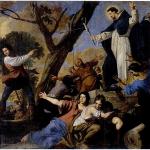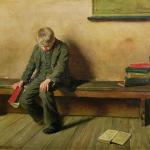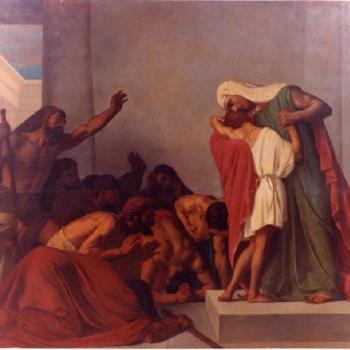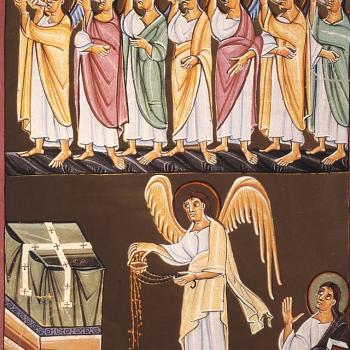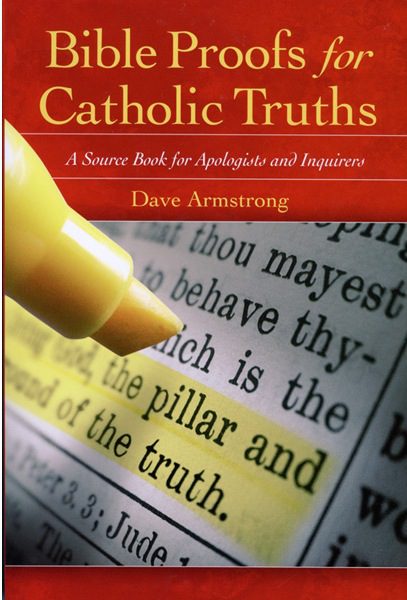
[From my 2009 book, Bible Proofs for Catholic Truths (see purchase information; just $2.99 for various e-book versions]
[Biblical passages are from the King James Version. My comments are italicized and in blue]
*****
Exodus 29:37: Seven days thou shalt make an atonement for the altar, and sanctify it; and it shall be an altar most holy: whatsoever toucheth the altar shall be holy.
Exodus 30:28-29: And the altar of burnt offering with all his vessels, and the laver and his foot. [29] And thou shalt sanctify them, that they may be most holy: whatsoever toucheth them shall be holy.
Leviticus 6:27: Whatsoever shall touch the flesh thereof shall be holy . . . (cf. 6:18)
2 Kings 2:11-14: And it came to pass, as they still went on, and talked, that, behold, there appeared a chariot of fire, and horses of fire, and parted them both asunder; and Elijah went up by a whirlwind into heaven. [12] And Elisha saw it, and he cried, My father, my father, the chariot of Israel, and the horsemen thereof. And he saw him no more: and he took hold of his own clothes, and rent them in two pieces. [13] He took up also the mantle of Elijah that fell from him, and went back, and stood by the bank of Jordan; [14] And he took the mantle of Elijah that fell from him, and smote the waters, and said, Where is the LORD God of Elijah? and when he also had smitten the waters, they parted hither and thither: and Elisha went over.
Elijah’s mantle is an example of a “second-class” relic: items that have power because they were connected with a holy person.
2 Kings 13:20-21: And Elisha died, and they buried him. And the bands of the Moabites invaded the land at the coming in of the year. [21] And it came to pass, as they were burying a man, that, behold, they spied a band of men; and they cast the man into the sepulchre of Elisha: and when the man was let down, and touched the bones of Elisha, he revived, and stood up on his feet.
The bones or relics of Elisha had so much supernatural power or “grace” in them that they could even cause a man to be raised from the dead. His bones were a “first-class” relic: from the person himself or herself.
Mark 5:25-30: And a certain woman, which had an issue of blood twelve years, [26] And had suffered many things of many physicians, and had spent all that she had, and was nothing bettered, but rather grew worse, [27] When she had heard of Jesus, came in the press behind, and touched his garment. [28] For she said, If I may touch but his clothes, I shall be whole. [29] And straightway the fountain of her blood was dried up; and she felt in her body that she was healed of that plague. [30] And Jesus, immediately knowing in himself that virtue had gone out of him, turned him about in the press, and said, Who touched my clothes?
Luke 8:43-48: And a woman having an issue of blood twelve years, which had spent all her living upon physicians, neither could be healed of any, [44] Came behind him, and touched the border of his garment: and immediately her issue of blood stanched. [45] And Jesus said, Who touched me? When all denied, Peter and they that were with him said, Master, the multitude throng thee and press thee, and sayest thou, Who touched me? [46] And Jesus said, Somebody hath touched me: for I perceive that virtue is gone out of me. [47] And when the woman saw that she was not hid, she came trembling, and falling down before him, she declared unto him before all the people for what cause she had touched him and how she was healed immediately. [48] And he said unto her, Daughter, be of good comfort: thy faith hath made thee whole; go in peace.
Jesus did say that the woman’s faith made her well, yet the instrumentality of a physical object in contact with Jesus was also a factor: as indicated precisely by its effect of causing “power” to go “forth from him.” God used the physical object for spiritual (and supernatural physical) purposes: a healing. We see it again, when Jesus heals the blind man:
John 9:6-7: When he had thus spoken, he spat on the ground, and made clay of the spittle, and he anointed the eyes of the blind man with the clay, [7] And said unto him, Go, wash in the pool of Siloam, (which is by interpretation, Sent.) He went his way therefore, and washed, and came seeing.
Jesus could have simply declared him healed, with no material object used. But, interestingly enough, Jesus didn’t do that. He used a bodily fluid (his own), and also clay, or dirt, and then the water of the pool, and rubbed the man’s eyes, to effect the miracle (two liquids, solid matter, and physical anointing action of fingers). The Bible thus teaches that physical things related to a holy person in some fashion can be channels to bring about miracles. This is exactly how Catholics view relics. There are several other examples of the same thing, with touch or matter of some sort being utilized to heal:
Matthew 8:14-15: And when Jesus was come into Peter’s house, he saw his wife’s mother laid, and sick of a fever. [15] And he touched her hand, and the fever left her: and she arose, and ministered unto them.
Matthew 9:28-30: And when he was come into the house, the blind men came to him: and Jesus saith unto them, Believe ye that I am able to do this? They said unto him, Yea, Lord. [29] Then touched he their eyes, saying, According to your faith be it unto you. [30] And their eyes were opened; and Jesus straitly charged them, saying, See that no man know it.
Mark 1:30-31: But Simon’s wife’s mother lay sick of a fever, and anon they tell him of her. [31] And he came and took her by the hand, and lifted her up; and immediately the fever left her, and she ministered unto them.
Mark 7:33-35: And he took him aside from the multitude, and put his fingers into his ears, and he spit, and touched his tongue; [34] And looking up to heaven, he sighed, and saith unto him, Ephphatha, that is, Be opened. [35] And straightway his ears were opened, and the string of his tongue was loosed, and he spake plain.
Mark 8:22-25: And he cometh to Bethsaida; and they bring a blind man unto him, and besought him to touch him. [23] And he took the blind man by the hand, and led him out of the town; and when he had spit on his eyes, and put his hands upon him, he asked him if he saw ought. [24] And he looked up, and said, I see men as trees, walking. [25] After that he put his hands again upon his eyes, and made him look up: and he was restored, and saw every man clearly.
Mark 9:26-27: And the spirit cried, and rent him sore, and came out of him: and he was as one dead; insomuch that many said, He is dead. [27] But Jesus took him by the hand, and lifted him up; and he arose.
Luke 13:12-13: And when Jesus saw her, he called her to him, and said unto her, Woman, thou art loosed from thine infirmity. [13] And he laid his hands on her: and immediately she was made straight, and glorified God.
Luke 14:2-4: And, behold, there was a certain man before him which had the dropsy. [3] And Jesus answering spake unto the lawyers and Pharisees, saying, Is it lawful to heal on the sabbath day? [4] And they held their peace. And he took him, and healed him, and let him go;
See also the examples of lepers healed by Jesus’ touch (Matt. 8:2; Mark 1:40-41; Luke 5:13), and touch used to raise the dead (Matt. 9:24-25; Mark 5:40-42; 8:53-55), and further similar examples in chapter 9. One of these miracles is particularly interesting:
Luke 7:13-15: And when the Lord saw her, he had compassion on her, and said unto her, Weep not. [14] And he came and touched the bier: and they that bare him stood still. And he said, Young man, I say unto thee, Arise. [15] And he that was dead sat up, and began to speak. And he delivered him to his mother.
Note that Jesus merely touched the bier that the coffin was being carried on, not even the person himself. Luke thought that this was important enough to mention. The implication is that grace was indirectly channeled by touch through the bier (an inanimate object) to the dead man, for the purpose of raising him.
Acts 5:15-16: Insomuch that they brought forth the sick into the streets, and laid them on beds and couches, that at the least the shadow of Peter passing by might overshadow some of them. [16] There came also a multitude out of the cities round about unto Jerusalem, bringing sick folks, and them which were vexed with unclean spirits: and they were healed every one.
St. Peter’s shadow is another example of a “second-class” relic. Jesus’ garments and saliva are also in this category.
Acts 19:11-12: And God wrought special miracles by the hands of Paul: [12] So that from his body were brought unto the sick handkerchiefs or aprons, and the diseases departed from them, and the evil spirits went out of them. (cf. Matt. 9:20-22)
This is a third-class relic: a thing that has merely touched a holy person or a first-class relic (St. Paul’s handkerchiefs and aprons).
***


